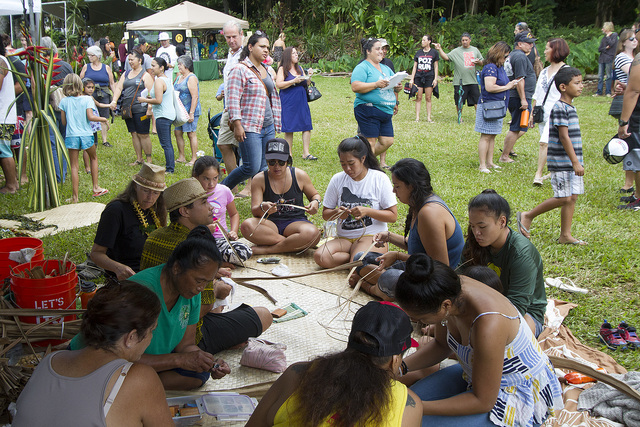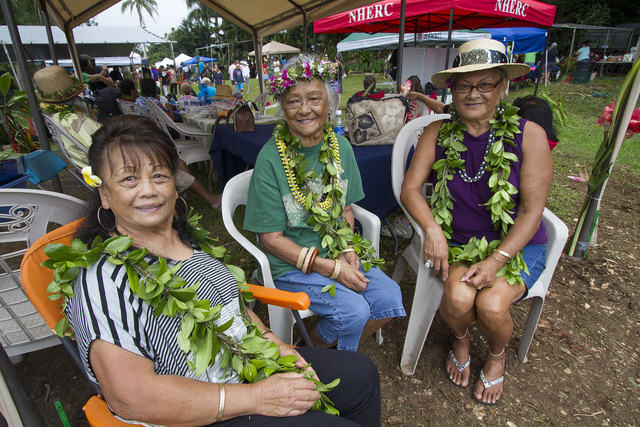The most surprising thing about the Waipio Kalo Festival on Saturday at Koaekea near the Waipio Valley overlook might have been that it was the first time such an event was hosted.
The most surprising thing about the Waipio Kalo Festival on Saturday at Koaekea near the Waipio Valley overlook might have been that it was the first time such an event was hosted.
After all, kalo (taro) is celebrated every day in the valley, where it has been grown for centuries.
Saturday’s inaugural festival honored not only the staple crop and all that comes from it, but the people it nurtures.
“The whole concept of the kalo festival has been in everyone’s heart and mind for a long time,” said Mahealani Maikui of organizing group Ha Ola O Waipio Valley.
The festival was about “revitalizing the community and honoring what our kupuna have done,” said Carl Sims III, who has farmed in the valley for close to 20 years.
Hundreds of visitors browsed the tents set up on the former rice mill property, learning about the dozens of varieties of taro and how to cultivate them, pounding poi, weaving lau hala and browsing craft booths. Local hula halau performed on the lawn while musicians sang onstage behind them.
Several exhibits told the story of taro in the valley via poster boards, but it was just as easy to ask a vendor: All had genealogies tracing back to Waipio and its small farming community.
Norma Laukong Loo, 73, started helping on her family’s taro farm when she was in fifth grade. It was expected everyone would help, she said.
“It’s hard work, but it’s fun,” Loo said.
There was no paved road into Waipio then, and pack mules carried taro up the steep dirt path to the processing facility. Loo and her friends and family walked up and down the same road to get to school. Going to a store was a treat.
Just about everything else you would need was in the valley: taro, fish, clear fresh water from the falls and springs.
Waipio, said Nellie Thomas Angelo, 75 and one of Loo’s cousins, is “a beautiful place, a loving place, a place that takes care of you.” It fosters independence and, at the same time, a powerful sense of community.
Gladys Hauanio Toko, 82, remembered that her sons had to pull taro before they could go off to play football. Toko’s son, Naaman, who was helping direct traffic during the festival, and his family still farm the 7-acre taro patch in the valley.
Toko and Loo both live in Kukuihaele now, part of a larger group of families that moved out of Waipio shortly before the 1946 tsunami swept in.
“Every chance I get I go down there,” said Kukuihaele resident Gertrude Ah Puck Lorenzo, who along with sister Pansy was born in the valley.
The Waipio lifestyle has changed little throughout the years, although the people who live by it have as new families moved in.
Earlier this year, the valley received one of the largest shocks to its system when the Bishop Museum in Honolulu, which owns more than 50 percent of Waipio, announced it planned to sell its holdings.
The uncertainty created by the announcement (no buyer or sale date has been set, and Bishop Museum president and CEO Blair Collis resigned in April for undisclosed reasons) prompted a resurgence in Waipio’s community spirit. The Waipio Valley Stakeholders Alliance was formed, combining the efforts of several local groups as they worked to develop a new stewardship plan.
A resolution introduced to the state Legislature this year requested the alliance work with the museum and Kamehameha Schools, which also owns large portions of Waipio, to coordinate efforts. The results of the stewardship planning are due to be presented during next year’s session.
In the meantime, the revitalization spirit continues.
The kalo festival was a way to “get the community out, and let’s just celebrate (Waipio),” Maikui said. “It’s nice because everybody’s smiling.”
Email Ivy Ashe at iashe@hawaiitribune-herald.com.


